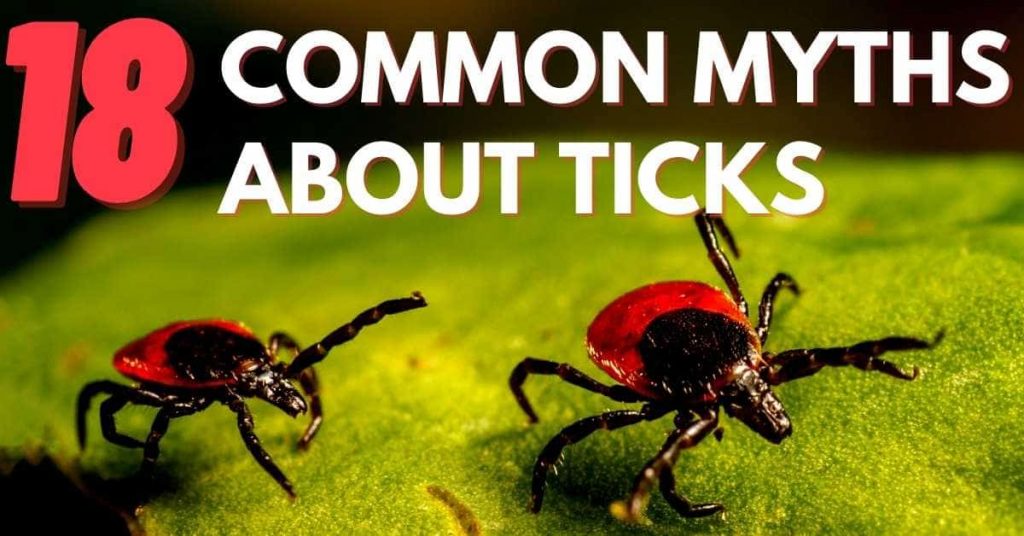
With warm weather comes ticks. The realization alone steals away from the joy of spring and summer. What would happen if you went out? Will a tick find its way to you and make you its host? Ticks are known to spread multiple diseases. What if you get one?
Impatient behavior surrounding the issue and general lack of knowledge results in the spread of misinformation. Misinformation ultimately results in uncalled for panic. Word of mouth leads to the wrong set of information regarding ticks to spread. Before leaving your house for a woodsy getaway, read more about the myths surrounding ticks and learn the truth about them.
Myth 1 – Ticks Are Easy To Detect
Most believe that you will know instantly when a tick latches itself on you and feeds. This is a very common myth. The reality is contradictory. When a tick bites you, you will not know. The reason is that tick bites do not hurt. Most bites are followed by reddening of the area. You are likely to notice it only after the tick falls off you. If followed by a rash or flu-like symptoms, you are likely infected with a disease transmitted by the tick.
You might also not see the tick on you since they are extremely small in size. An adult tick is only 3-5mm in length. Unlike common beliefs, they are tough to detect which allows them to transmit a multitude of diseases very easily. Not to forget that a tick can take anywhere between a few hours and a few days before it finishes feeding. The more it feeds, it will increase in size, and you might be able to locate it. Remember, you will see the tick because its size increased, not because you could feel the bite. Apart from this, signs like redness of the area bitten let you know that a tick was on you. When first attached, the tick will roam around your body till it finds soft folds in your skin it deems suitable to feed on. These areas typically include your scalp, groin, the skin behind your ears, armpit, and the skin between your fingers and toes. The tick will not give you multiple bites. It will bite once, which will be painless, and feed till it’s full before falling off.
Myth 2 – If You Have Lyme Disease, You Have A Bullseye rash
One of the most common symptoms associated with Lyme disease includes a bullseye rash, yet up to 30% of patients do not have this symptom. This myth leads to many ignoring other more prevalent symptoms of Lyme disease. Because of this, multiple patients suffer a late diagnosis and the complications that come with it. You should learn all about ticks and tick diseases that might help you stay away from those myths.
Lyme disease is caused by Borrelia burgdorferi and rarely Borrelia mayonii bacteria. It is the most common vector-borne disease in the US. Black-legged ticks mainly transmit it to humans. Once detected, it is treated using a two to four-week course of antibiotics. This usually includes doxycycline, amoxicillin, and cefuroxime. You might still experience mild symptoms like pain, fatigue, and more for up to six months.
When Lyme disease is left untreated, it can lead to chronic conditions. These range from chronic joint inflammation to cognitive defects. Aside from the bullseye rash, multiple patients report flu-like symptoms. If you are spending time outdoors in places where ticks can find their way to you, you need to be on the lookout for specific symptoms. These include a persistent headache, stiffness in your neck, body, sudden sensitivity to light, nerve pain, and swollen lymph nodes. Usually, when you do not get a bullseye rash, these tend to be the prominent early symptoms of Lyme disease. You can have Lyme disease even without a bullseye rash.
Myth 3 – A Tick Head On Host Is Dangerous Even Without The Body
Many believe that if you remove a tick and its head stays embedded, you have a higher chance of contracting tick-borne diseases. Usually, you should be able to pull out a tick entirely in one go with tweezers, but if that does not happen and you are left with a disembodied head embedded in your skin, there is no need to panic. The head alone will not move around, and it does not increase your risk of getting tick-borne illnesses. But the head can increase your chances of certain bacterial infections. Ticks’ heads carry all types of germs. Germs you would rather not have in your skin. Patiently try to remove the tick’s head using tweezers. If that does not work, try using a sterile needle. If you fail to do so, seek a medical professional.
Myth 4 – Ticks Can Jump
It is entirely untrue that ticks can jump because their anatomy allows them to seek their hosts through questing. They have four pairs of legs (four pairs in the nymph and adult stages). There is a lack of segmentation as their abdomen is completely flat. Lack of segmentation allows them to latch onto a host easily and makes feeding easier without the host noticing.
They position themselves on top of grass blades using the spines in their legs and stretch the front pair of their legs outward. They wait to attach themselves to a prospective host. Additionally, there is a tiny claw at the end of their legs. They also have short spine hairs on their legs. When a tick is questing, it will latch onto a host as they brush past it. Once attached, they roam around the host’s body to find the soft corners to feed on. These areas include the skin folds between fingers and toes, the host’s hairline, and behind the ear.
Myth 5 – Ticks Are Only Active Outdoors
This is not true. Though most ticks prefer humid and moist environments, Brown Dog ticks can thrive indoors. Though dogs are the primary host for this tick, many bite humans. Brown dog ticks, unlike most tick species, can be found indoors. They prefer densely populated areas with humans and dogs. They can be found all year in the southern United States. Their brown bodies serve as a means of identification. Their capituli, which has a sharp outward point on either side, is also a distinguishing feature. Because they can survive indoors for the entirety of their lifecycle, a few ticks can cause severe infestation problems. They are linked to the transmission of several diseases, including Rocky Mountain Spotted Fever in humans and Canine Ehrlichiosis in dogs.
These ticks can live without a host for up to five months. It also has a three-stage feeding pattern, but it feeds on the same host throughout its life. They will attempt to live in the same house due to this. They will molt into their next stage after dropping off their host after feeding. Because they live indoors, they are active all year, and their life cycle differs from that of most ticks. As a result, the cycle can be completed in two months.
Myth 6 – You Can Not Encounter Ticks In Winter
Given a tick’s life cycle, it is understandable, most blindly believe that winter is tick-free. Even though winter is the time most ticks tend to go dormant, it does not negate the possibility of being bitten by a tick during winter. The activity of Blacklegged/Deer tick only decreases when the temperature drops below 35 degrees Fahrenheit. On the other hand, the Gulf Coast ticks are active in January. Do remember some ticks like the American Dog tick and Lone star ticks are generally inactive in fall and winter. The temperature needs to be below 10 degrees Fahrenheit for a few days to ensure the dormancy and death of certain species.
Deer ticks are carriers of Lyme disease, Anaplasmosis, and more. Adult female deer ticks can be easily spotted. They have a reddish-brown body and a black shield that graces their back. On the other hand, Gulf Coast ticks transmit Rickettsia parkeri, which results in Rickettsiosis. The symptoms range from rash to fever and headaches. They thrive in dryer elements and can cause tick paralysis. It is easy to identify them with their red bodies that sport white marks. While adult males have a white weblike structure on their bodies, adult females have white spots on their dorsal shields.
Myth 7 – Use Heat To Remove Ticks If Tweezers Seem Painful
The only way to get rid of a tick is to burn it. While burning a tick off the skin may appear to be a satisfying and foolproof method of removing the bloodsucker, it is also the worst method. Applying heat can increase (the tick’s) saliva production and, if infected, pathogen transmission. In addition to burning yourself or starting a fire, you may end up with a scorched tick attached to your skin.
Its mouthparts are shaped like an anchor with backward point spines, so it’s physically attached until that tick decides it wants to release itself. Tweezers are the best tool for removing ticks. Grab the tick as close to the skin as possible and pull it straight out. If you are concerned about Lyme disease or another tick-borne illness, you can save the tick and have it tested by your doctor. Simply place it in a freezer bag. Grasp the tick as close to the skin’s surface as possible with clean, fine-tipped tweezers. Pull up with even, steady pressure. If you twist or jerk the tick, the mouthparts may break off and remain in the skin. If this occurs, use tweezers to remove the mouthparts.
Myth 8 – Liquid Soap Can Be Used For Tick Removal
Multiple websites suggest that an attached tick can be removed using liquid soap. According to the method, you need to apply liquid soap to a cotton ball. Cover the attached tick with this for fifteen to twenty seconds. In theory, this will make the tick come out on its own and get stuck to the cotton ball when lifted away. This method is widespread, but countless health experts have stated it is ineffective.
Those who saw positive results using this method may have experienced it due to coincidence. The ticks that get removed using this method are most likely because they have finished feeding. These are usually male ticks who tend to be intermittent feeders. They only attach themselves to the host for a short period.
Female ticks, on the other hand, stay attached longer. They lock themselves in the host’s skin using their mouthparts and saliva with a cement substance to prevent falling off early. This renders removal using liquid soap ineffective. Rather than helping in removal, soap can actively irritate a tick and trigger the injection of salivary fluids. Tweezers are the best and most effective way of removing ticks.
Wear gloves and remove the tick gently from your skin using tweezers. This should be done in a slow upward motion. Do not twist or squeeze the tick while removing it. You should be able to remove the tick entirely in one go. If certain mouthparts remain and you cannot remove them, leave them as it is. Do not forcibly pull them out. Your body will naturally expel these parts.
Myth 9 – Ticks Are Capable Of Smelling Blood
Ticks are not capable of smelling blood. Instead, they use other ways to find hosts. They can find a host through odors, vibrations, body heat, the breath of the host, and sometimes even their shadows. The ability to smell in ticks is due to the presence of Haller’s organ. This allows them to detect multiple chemicals like ammonia, carbon dioxide, and pheromones. Apart from this, this same organ can also sense infrared light and humidity. This also includes the body heat of warm-blooded animals. They wait on top of grass blades and shrubs for the perfect opportunity to latch onto their host. Additionally, ticks can identify the route taken by their potential host frequently or regularly.
Myth 10 – Deer Ticks Are The Only Dangerous Ticks
There are almost 800 species of ticks that are known to humans. Multiple species are capable of causing diseases. Deer ticks (black-legged ticks), also known as Ixodes Scapularis, are not the only ones capable of transmitting diseases. Other ticks which can transmit diseases include American dog ticks, Rocky Mountain Wood tick, Brown dog tick, and more. Ticks can transmit and result in up to 65 diseases to humans. The transmitted disease can pose a threat to be life-threatening. Since ticks are hard to detect, their bites can go unnoticed. This can result in delayed treatment of the transmitted disease since some have symptoms that resemble a common cold. Delayed treatment can make the disease life-threatening. It can either result in death or complications such as cognitive defects, which are permanent.
Myth 11- Once Attached, Ticks Burrow Under The Host’s Skin
Ticks do not burrow under the host’s skin. A tick, once done feeding, will simply drop off rather than staying attached and burrowing. Ticks feed at every stage of their life cycle. They latch onto the host through questing since they can not jump or fly. Once attached, they look for a soft spot on the host to feed on. Parts of the tick’s head can lodge in your skin as they feed, but they will not wholly burrow under the skin. The reason is ticks spend as little time on the host as possible. Their only purpose is to feed enough to carry with necessary life processes and molt. They will increase in size as they feed and then fall off once finished.
Myth 12 – Use Perfume, Vaseline, More To Remove Ticks
As part of home remedies to remove ticks, perfume and vaseline are also recommended, but it is more harmful than practical. The method entails dousing the tick in perfume, vaseline, or petroleum jelly. This is done using a cotton ball. In theory, the tick will come out on its own and get stuck to the cotton ball when pulled away. In reality, this method brings more harm than good. When these chemicals are applied to the tick, the tick would get irritated and regurgitate its stomach contents back into you.
This will trigger the injection of salivary fluids and an increased risk of disease transmission. Health experts have reiterated that tweezers are the most effective in tick removal. Using a pair of tweezers, gently remove the tick from your skin. Do not twist or squeeze the tick and pull it out in a slow upward motion. Ensure no part of the tick remains lodged in your skin. If certain mouthparts remain, do not forcibly pull them out. Your body will naturally expel them.
Myth 13 – Ticks Find A Host To Feed Off By Falling Off Trees
It’s a common myth, but ticks do not fall from trees to find their host. Ticks are incapable of jumping, flying, or falling off trees to find hosts. They seek their hosts through questing. Using the spines in their legs, they latch onto grass blades and shrubs. They stretch the front pair of their legs outward and latch onto a host when they brush past the tick. They also have a tiny claw at the end of their legs with short spine hairs on their legs.
There is a complete lack of segmentation in a tick’s body. Because of this, their abdomen is entirely flat. This allows them to attach to the host without them noticing seamlessly. After the tick finishes feeding, it will drop from the host. Their anatomy allows them to look for hosts through questing. They usually quest on lower levels of any given environment, given they can not jump or fly.
Myth 14 – Use Your Fingers To Remove Ticks
Ticks should never be touched with bare hands. Firstly, if it is an engorged tick and you use your fingers to remove or crush it, you can contact infected blood, making you sick. Secondly, apart from blood, you can come in contact with their saliva. Again, the right way to remove a tick is to pull it out using a pair of sharp-tipped tweezers. If certain mouthparts remain embedded and cannot be removed using tweezers, do not use your fingers. It is always a bad idea to let your bare skin come in contact with a tick. Those mouthparts are incapable of transmitting diseases on their own. Your body will naturally expel them. You can dispose of the tick by putting it in alcohol, flushing it down the toilet, putting it in a sealed bag, and wrapping it in tape.
Myth 15 – Turn A Tick Clockwise/Counter-Clockwise For Easy Removal
The process of removing a tick on your own is pretty simple. Use a pair of tweezers and gently pull the tick out in one go using a steady upward motion. At no cost should the tick be turned during removal. If you turn a tick clockwise or counter-clockwise for removal, parts of it can remain embedded in your skin.
If that happens and you cannot remove the embedded parts, do not force them out. You can end up pushing them even further. Your body will naturally expel them. If there is an issue, contact or visit your nearest healthcare provider. Even though those parts aren’t necessarily harmful, they increase the risk of bacterial infection if left for long.
Myth 16 – Ticks Are Insects
Contrary to popular belief, ticks are not classified as insects. They are classified under the same category as spiders. They fall under Arachnida, which is a class of Arthropods. In simple words, ticks are parasites that are only second to mosquitoes in spreading diseases. They feed off the blood from their host for survival.
Though similar to mosquitoes, Ticks possess distinct features that make them part of the Arachnid class. They contain four pairs of legs like spiders. Additionally, ticks are closer to spiders and scorpions (under Arachnida) than mosquitoes; hence they are grouped under Arachnida. Ticks lack segmentation in their abdomen as it is fused with the cephalothorax. Ticks are tiny in size, and their legs have spines and short spine hairs. There is also a tiny claw at the end of their legs.
Myth 17 – If Left Attached For Long, It Will Lay Eggs Inside You
Uncontrolled fear can result in a ton of misinformation spread via the bubble of social media. Ticks will never lay eggs on or in their host. Female adult ticks fall off the host after they finish feeding. Rather than staying on their host, they will look for a suitable sheltered place to lay eggs.
Before laying eggs, female adult ticks feed to store the blood required for reproduction. Still, the eggs can cause a problem. Once detached from the host, the female adult tick will lay eggs in your immediate environment. This can cause many issues since a single female adult tick is capable of releasing thousands of eggs.
If you find tick eggs in your house, the best way to deal with them is the use of table salt. Sprinkle a generous amount of salt on the eggs and leave them for a week. The salt will dehydrate and kill the eggs. If you come across tick eggs in your backyard, use pesticides to kill them. Mow the grass to make ticks leave. Lack of tall grass to quest on will force them to leave.
Myth 18 – Ticks Only Carry Lyme Disease
Many believe that any tick bite will only result in Lyme disease. This is simply not true as ticks act as vectors that carry multiple pathogens. These pathogens are of varying types. Once transmitted, they are capable of causing various bacterial and viral infections.
Lyme disease is the most widely known tick-borne disease, and many believe it is the only one. Ticks are capable of spreading up to 65 diseases. These include Powasson disease, Tularemia, Encephalitis, Rocky Mountain Spotted fever, Colorado tick fever, and more. Most of them are treated using a two to four-week course of antibiotics. This usually includes Doxycycline. Additionally, the initial symptoms observed for most of these diseases resemble flu. This difficulty in tick detection can result in delayed diagnosis. Ultimately, delayed or no treatment can lead to complications that result in chronic damage.
Disease Transmission Risk
Once attached, ticks find a soft spot to feed on. Then they feed through a feeding tube they insert into the host’s body. The tick uses its chelicerae to cut the host’s skin. From here, the feeding tube is inserted. This feeding process allows ticks to transmit diseases. Even though not all tick bites lead to diseases, it is better to be careful. As mentioned above, ticks can find their host’s through vibrations, body odor, body heat, and even the potential host’s shadow.
Ticks can identify the route that their potential host frequently takes. Since they cannot fly or jump, they quest on top of grass blades and shrubs to latch onto their host when they brush past them. The time it takes a tick to feed varies depending on the species. Based on these factors, it can take a tick anywhere between ten minutes and a few days to finish feeding. The diseases transmitted by ticks are vector-borne infections.
The tick can feed off a host already diagnosed with a blood-borne infection. Under these circumstances, the tick will ingest pathogens from the host and carry them with it for the rest of its life cycle. The tick will pass them along to future hosts as well. After feeding the infected host, the tick will fall off and prepare for its next life stage. Post this, when the tick goes to feed again, the pathogens from its previous host will get transmitted to the new host through the tick’s saliva.
Ticks can cause a plethora of diseases. These range from Lyme disease to Tularemia. These diseases are usually treated with a course of antibiotics. While most fully recover, late treatment can result in life-threatening complications.
Preventing Ticks
Ticks need to be prevented from getting in contact with your skin. Firstly, chemical repellents that contain DEET, picaridin, or permethrin should be used. It is better to wear light-colored clothing when outdoors in woody areas so that you can spot a tick on yourself. The clothes you choose to wear to outings matter as well. They need to cover your arms and legs completely. You can tuck your pants in your socks for extra protection. Taping openings in clothes shut can also help.
Additionally, keep to the center of the trail. This will make you less likely to come in contact with questing ticks. Questing ticks tend to stay on top of grass blades in shrubs and bushes. After returning, make sure to check yourself for ticks. If possible, ask someone else to do it for you. Run a fine-tooth comb through your hair to remove ticks, if any. Aside from this, it is better to shower and wash your clothes at high heat to kill and subsequently remove any ticks that went undetected before.
Final Words
Ticks can be dreadful but not as terrible as the myths mentioned above. Follow the preventive measures rightfully and keep deaf ears to the myths revolving around ticks.


